1. What is pallet racking?
Pallet racking structures are made from steel and are used for the storage of pallets above the floor on levels (or shelves) created by beams within industrial warehouse settings. Space Rescue has a large range of warehouse pallet racking uprights, frames, and beams for sale in both new and second-hand condition. Our Pallet Racking is available for sale in Sydney, Melbourne, Brisbane, Adelaide and Perth.
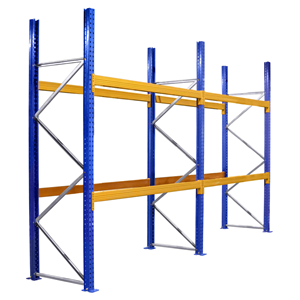
2. Summary of specifications
Frames: 914mm up to 7315mm (heights) and 609mm, 838mm, or 1219mm (depths)
Beams: 914mm up to 4877mm (clear entry length) and with various section sizes from 50mm x 45mm to 140mm x 50mm
Accessories: pallet cages, upright protectors, fork entry bars, and mesh decks, for example.
2nd Hand: large range of used pallet racking in various brands and sizes.
3. Dimensions and sizes of pallet rack components
A variety of standard frame heights, bay widths, and shelf/frame depths make this type of shelving suitable for almost any location. Please refer below for more information on individual warehouse pallet rack components.
a) Frame heights
Please find below some common frame heights.
- 914mm
- 1829mm
- 2133mm
- 2438mm
- 3048mm
- 3658mm
- 4267mm
- 4877mm
- 5486mm
- 5791mm
- 6096mm
- 6704mm
- 7315mm
b) Beam lengths (or bay widths)
Below are some common beam lengths: To explain, these are the resulting measurements taken between the uprights. The overall beam length is approximately 100mm more when you include the beam end connectors that provide the connection to the upright.
- 914mm
- 1372mm
- 1524mm
- 1829mm
- 2133mm
- 2438mm
- 2591mm
- 2743mm
- 3048mm
- 3350mm
- 3658mm
- 3810mm
- 4267mm
c) Frame widths (or shelf depths)
Below are some common frame widths.
- 609mm
- 838mm
- 1219mm
Note: A frame depth of 838mm (or 840mm) specifically suits Australian Standard Hardwood Pallets. [Other pallet or skid sizes may work better with a deeper frame and the use of mesh decks.]
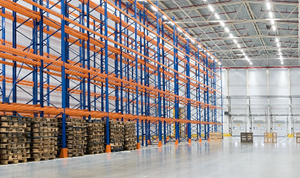
4. Pallet Rack Beams
Beams (i.e., the horizontal pallet rack members) directly support the loads imparted by pallets and shelving set-ups with mesh decks or boards. They are typically orange in colour.
a) Length
When discussing beam length, the distance between the end connectors is typically used. The term used for this length is ‘clear entry’. It refers to the freely available horizontal space for storage between these connectors. Therefore, the overall beam length is made up of the ‘clear entry’ length plus the width of the two end connectors at each end of the beam. Furthermore, the clear available space for storage between frames is not too dissimilar to the beam’s ‘clear entry’. It only differs by the end connector material thickness plus any small gaps between the inside of the connector and the outside of the frame upright. Please refer to the list above for a list of some common sizes.
b) Beam Profile Height
The profile height is a measure of the height of the long uniform section that is between the end connectors. They are typically rectangular in shape and range in height from 50mm to 140mm. Most are rectangular box sections, though a few are open sections with a gap on the bottom rectangular side.
c) Beam End Connectors
As has been noted above, the ends of the beams are referred to as the end connectors, while the steel piece joining them is called the beam section. Welded to the beam section are the end connectors. Beam sections come in a variety of profiles, including ‘Box’, “I’ (similar to RSJ’s), and ‘Open’ (an upside-down U section that is open at the bottom). Their height generally ranges from 40mm up to 150mm.
d) Strength
Several factors influence the safe load-carrying capacity of the beam, including end connector size and effectiveness (also known as fixity, which is a measure of its ability to withstand rotation), the size and shape of the beam profile, and the grades of steel used within the beam itself.
e) Finish
A bright safety orange or blue colour is the most common finish for the beams. The type of paint used is powder-coat enamel for the beams. Other finishes are also available. We also stock second-hand pallet racks for sale.
5. Pallet Rack Frames
Frames (or end frames) consist of two vertical uprights (or posts or columns) connected by frame bracing.
a) Uprights (or Posts)
The process for making uprights involves cold-rolling coil steel within a rollformer. A variety of steel thicknesses, shapes, and sizes are both used and created depending on the strength required and the application of this important piece of the frame. Please refer to the table above for a list of some common heights.
b) Bracing
Bracing is the term given to slim strut-like members that are used to join two uprights together in a truss-like manner. Also, there are two types: horizontal and diagonal frame braces.
c) Base Plates
At the bottom of each upright is the baseplate, or footplate. Firstly, each upright imparts a vertical point load to the ground. Then, the footplate reduces the point load by spreading this vertical load into the slab more evenly. Finally, the baseplate secures the structure to the concrete floor with the use of floor anchors.
d) Row spacers (also known as frame spacers)
In double-sided pallet racking runs, we use a row spacer to separate the two adjacent pallet racks with uniform spacing. These spacers not only improve front-to-back rigidity but also ensure, during installation, that the appropriate space is created so that pallets on either side do not interfere with each other during placement and retrieval.
e) Strength
The strength of the frame is dependent on both the uprights and the bracing pattern used.
f) Finishes for posts and bracing
A pre-galvanised (or zinc) finish is the most common finish now for posts and frame bracing. Previously, the posts and bracing had a powder-coat finish. To save on manufacturing time and cost and hence remain competitive, the painting of frames has largely stopped.
6. How to calculate the overall length of pallet racks
To explain, you can determine this by adding the number of pallet racking beam lengths in the run to the frame thickness (or upright width). Also, the designated beam length represents the distance between the left and right end frames or beam end connectors. The name given for this dimension is the clear entry bay width.
In detail, to calculate the length of a starter bay, you would simply need to add the widths of the two end frames or posts (typically around 90mm) on both the left and right sides plus the designated beam length.
Finally, for each add-on bay, you would need to add the designated beam length plus only one end frame width. As shown above, the width of the end frame that you are joining on to is already included within the starter bay length.
7. Second-hand pallet racks for sale
Space Rescue likes to be able to offer a large variety of second-hand pallet racks, particularly in most of the major brands. They include Dexion, Colby, Schaefer, Apex, and APC, to name just some of them. We take pride in what we sell, and hence we source only good-condition pallet racking frames and beams. In addition, Space Rescue will often buy back your used pallet rack, depending on its condition and our stock holding at the time.
a) Second-hand pallet racking frames
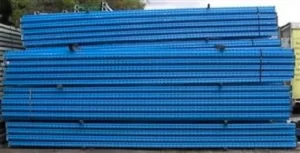
Typically, the most common frame depth available is 838 mm, though others are also available. A variety of heights are also available in our second-hand pallet rack stock.
b) Second-hand pallet racking beams
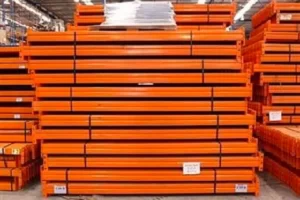
Also, the most common sizes of used beams available create a 2591mm (or 8.5 foot) or 2743mm (or 9 foot) clear entry bay width. As has been noted above, this term ‘clear entry’ refers to the clear available space for storage between adjacent frames.
c) Second-hand pallet rack shelving materials for sale
In addition to the above, we also have a choice of second-hand mesh decks and second-hand pallet racking boards available for sale.
8. Accessories for Warehouse Pallet Racking
a) Upright Protectors
Upright protectors obviously protect the upright from damage and are available in a variety of types. Impact from a forklift is the most common cause of damage. Examples include corner guards, column guards, and rack-end protectors.
b) Pallet Rails
Pallet rails run from the aisle to the rear pallet location, particularly to help the forklift operator safely and correctly position pallets. These are common in double-deep and narrow-aisle pallet racking shelving structures.
c) Mesh Decks
Mesh decks provide extra protection for either skid or non-standard pallet sizes. They also provide shelf storage within pallet racking.
d) Fork Entry Bars
Fork entry bars are used when storing products that are not stored on pallets. An example of this is timber boards. Multiple fork entry bars sit directly on top of a pair of beams to create a support level. They create a gap of approximately 70mm between the underside of the product and the top of the beam.
e) Pallet Support Bars
Pallet Support Bars create additional support, particularly for heavily loaded pallets and skids. Multiple pallet support bars sit directly on top of a pair of beams to create a support level. This level typically sits about 5mm above the top beam surface.
f) Pallets and Skids
Both pallets and skids provide a strong, stable base for placing products on. The materials used to make pallets and skids are specifically timber, aluminium, and steel.
g) Pallet Cages and Stillages
Both pallet cages and stillages contain loose items within the confines of a pallet footprint. They simplify the handling of the product.
9. How to Select Your Pallet Racking Storage Structure
Depending on the nature of the business, you may employ a combination of types of pallet storage structures to optimise your operation.
You will need to consider the following pallet factors when selecting the most suitable storage structure:
- Firstly, the type of pallet
- Then, the size of the pallet, that is, the width (including product overhang), depth (including product overhang), and height of the product on the pallet (including the pallet itself),
- Then, the maximum weight of the loaded pallet (including the pallet itself)
- Then, the commonality of the pallet (that is, the commonality of the product)
- And finally, the required accessibility of the pallet (taking into account product life, expiry, etc.)
Below is a list of the most common types of both static and dynamic pallet rack structures available for sale by Space Rescue.
10. Static Warehouse Pallet Racking for Sale
Static structures are warehouse pallet rack structures without any moving parts. However, that is not to say that these structures are not designed to deflect under load. To explain further, the pallet or stored item does not move after storage.
a) Selective pallet racking
Selective Racking is the simplest, most common, and least expensive of the Pallet Rack family. It is ideal for use in situations where you require selective access to each individual pallet from the forklift aisle. This style of warehouse racking consists of just vertical frames, horizontal beams, row spacers, levelling shims, and floor anchors.
b) Pallet Rack Shelving
Pallet rack shelving is often thought of as shelving for pallets or palletized goods. There are other applications for warehouse pallet racks, including standard flat shelving. Adding specific products to the beams creates a flat shelf surface for pallet rack shelving. These products include shelf boards, board stiffeners, and mesh decks.
The picture below is a good example. It shows the use of boards on the lower levels of the pallet racking bays and pallets stored above.
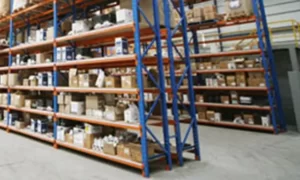
c) Drive-in racking
Drive-in Dexion Pallet racking consists of multiple lanes for the storage of multiple identical pallets. It basically suits warehouses where there are many pallets of the same S.K.U. (‘stock keeping unit’).
It is one of the most space-efficient storage systems available. To explain, the reason it is such an effective way to store your pallets is simply due to the reduced number of forklift access aisles to service a high quantity of pallets compared with selective or double-deep structures.
Pallets are stored on multiple rail levels within each lane (or bay). The product on each pallet within the same bay needs to be identical, as you are only generally able to access the pallet that is closest to the aisle. In summary, the forklift drives into a lane to deposit and retrieve pallets from this integrated rail and post structure.
d) Double Deep Pallet Racking
Double Deep Racking usage is recommended for those businesses with a range of S.K.U.’s (‘stock keeping units’) that require multiple pallets to fulfil safety stock levels. It is the second most common type of both structure used and pallet racking for sale.
As the name suggests, pallets are stored two deep on each side of the aisle. The rear pallet may not be accessed until the front pallet (i.e., the pallet closest to the aisle) has been removed. Due to pallet commonality, this does not create a problem unless there are stock rotational requirements due to expiration date issues.
This style of rack for sale requires a special forklift with the ability to reach into the second pallet position. Depending on the type of forklift used, it is sometimes recommended that pallet guide rails be used on the upper levels to help the forklift operator place and retrieve pallets safely on the upper pallet storage levels. Double-deep rails run from the aisle to the rear storage location.
e) Narrow Aisle Racking
Narrow Aisle Racking achieves higher storage-to-footprint ratios than Selective’s equivalent pallet storage capacity. In short, smaller aisles take up less space. It must be remembered that special forklifts and picking machines are needed to service these aisles.
For very tall structures with a large footprint (also known as high bay warehouses), it is not uncommon for automated cranes to service them. With economies of scale, one can justify the great expense of an ASRS (Automated Storage Retrieval System) by its speed and tireless 24/7 endurability.
f) Workbenches
You can use pallet racks to create a pallet rack workbench. They are particularly sturdy. By joining bays together, you will be able to create any length of workbench.
g) Cantilever Racking
Cantilever racking is not a style of pallet racking. However, it is a great way of storing long products such as pipes, tubes, and long crates. Arms positioned at the same height create a storage level. Support arms join the post on one end only. This is to provide open access on the aisle side. Both single- and double-sided structures are available.
h) Vertical Racking
Vertical racks consist of pallet racking materials; however, they are not a style of pallet racking either. This structure provides a clever way for storing both long and light products, such as conduits and tubes, for example, in a vertical orientation.
11. Dynamic Warehouse Pallet Racking Structures
Dynamic structures are those racking systems where the product and/or structure move as part of their operation. They are a great space-saving alternative to traditional static pallet racking shelving styles. However, these structures, with their gravity wheel lanes and mobile bases, are more expensive when compared to the cost per pallet storage position of static structures.
a) Push-Back Racking
Warehouse push-back racking offers the ‘best of both worlds’ in terms of greater selectivity and a lesser number of forklift aisles. This structure is typically 3 or more pallets deep and consists of a front wall of pallet-sized openings. Within each opening is a lane with rails and rollers that feed pallets to the aisle by gravity.
This structure stores pallets by inserting them into a particular pallet opening and pushing the front pallet back up the lane. Retrieving a pallet simply involves working in reverse. Removing the rear pallet enables the pallets behind it to slide forward. This, therefore, positions and reveals a new front pallet.
The one bay can store different pallets without limiting selectivity; however, each bay level must store pallets of identical make-up. Similar to the drive-in rack, ‘FILO’ pallet movement (i.e., first-in, last-out) does not suit products with expiry dates.
b) Flow-through racking
Flow-through racking offers several major advantages, including dense storage, limited aisle space requirements, good selectivity, and excellent stock rotation.
c) Mobile Racking
Mobile racking achieves greater storage density while maintaining selectivity by moving the rack to create an aisle. To explain, it consists of pallet racking runs that sit on top of mobile bases. Multiple runs require only one aisle space. When rows of racks are moved to create an aisle gap between racks, you are then able to access the pallets adjacent to the newly formed aisle.
12. Applications for Pallet Racking
Pallet racking is essentially industrial shelving for both pallets and skids. Lower shelf levels store other products in many situations. Placing boards or mesh decks on top of the beams (or rails) will create pallet rack shelving or industrial shelving.
With a clean, open design and a choice of either board, mesh decks, pallet support bars, or fork entry bars, pallet rack shelving may be used for a large variety of applications within warehouses, factories, industrial chillers, industrial freezers, and industrial units.
13. Availability and Service Offering
Space Rescue typically has good stocks of warehouse pallet racks available. The brands we carry specifically include Dexion, Colby, Schaefer, APC, Global, Brownbuilt, and Apex Pallet Racking.
We deliver and install pallet racks for sale across Australia, in all regional areas and towns. Alternatively, you may collect from one of our capital city warehouses, if you prefer.
Our offering includes pallet racking installation, dismantling, relocation, and pallet racking inspection.
14. FAQ
Yes, we highly recommend using appropriate floor anchors to attach your pallet racking to an approved concrete slab of sufficient strength and thickness. This is especially the case when you are using machinery (such as a forklift or walk-behind forklift) for loading and unloading. Anchoring is important for both the front-to-back and down-aisle (or side-to-side) stability of the structure.
This style of pallet racking has all pallets stored directly adjacent to the aisle. It is called selective as every pallet is immediately accessible from a standard forklift without having to move other pallets out of the way.
15. Other Products
You may also be interested in our mezzanine floors, second hand shelving, container ramps and used compactus?
